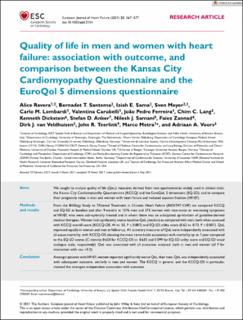| dc.contributor.author | Ravera, Alice | |
| dc.contributor.author | Santema, Bernadet T. | |
| dc.contributor.author | Sama, Iziah E. | |
| dc.contributor.author | Meyer, Sven | |
| dc.contributor.author | Lombardi, Carlo | |
| dc.contributor.author | Carubelli, Valentina | |
| dc.contributor.author | Ferreira, João Pedro | |
| dc.contributor.author | Lang, Chim C. | |
| dc.contributor.author | Dickstein, Kenneth | |
| dc.contributor.author | Anker, Stefan D. | |
| dc.contributor.author | Samani, Nilesh J. | |
| dc.contributor.author | Zannad, Faiez | |
| dc.contributor.author | van Veldhuisen, Dirk J. | |
| dc.contributor.author | Teerlink, John R. | |
| dc.contributor.author | Metra, Marco | |
| dc.contributor.author | Voors, Adriaan A. | |
| dc.date.accessioned | 2022-04-08T09:12:05Z | |
| dc.date.available | 2022-04-08T09:12:05Z | |
| dc.date.created | 2022-01-13T18:19:12Z | |
| dc.date.issued | 2021 | |
| dc.identifier.issn | 1388-9842 | |
| dc.identifier.uri | https://hdl.handle.net/11250/2990719 | |
| dc.description.abstract | Aims
We sought to analyse quality of life (QoL) measures derived from two questionnaires widely used in clinical trials, the Kansas City Cardiomyopathy Questionnaire (KCCQ) and the EuroQoL 5 dimensions (EQ-5D), and to compare their prognostic value in men and women with heart failure and reduced ejection fraction (HFrEF).
Methods and results
From the BIOlogy Study to TAilored Treatment in Chronic Heart Failure (BIOSTAT-CHF) we compared KCCQ and EQ-5D at baseline and after 9 months in 1276 men and 373 women with new-onset or worsening symptoms of HFrEF, who were sub-optimally treated and in whom there was an anticipated up-titration of guideline-derived medical therapies. Women had significantly worse baseline QoL (median) as compared with men, both when assessed with KCCQ overall score (KCCQ-OS, 44 vs. 53, P < 0.001) and EQ-5D utility score (0.62 vs. 0.73, P < 0.001). QoL improved equally in women and men at follow-up. All summary measures of QoL were independently associated with all-cause mortality, with KCCQ-OS showing the most remarkable association with mortality up to 1 year compared to the EQ-5D scores (C-statistic 0.650 for KCCQ-OS vs. 0.633 and 0.599 for EQ-5D utility score and EQ-5D visual analogue scale, respectively). QoL was associated with all outcomes analysed, both in men and women (all P for interaction with sex >0.2).
Conclusion
Amongst patients with HFrEF, women reported significantly worse QoL than men. QoL was independently associated with subsequent outcome, similarly in men and women. The KCCQ in general, and the KCCQ-OS in particular, showed the strongest independent association with outcome. | en_US |
| dc.language.iso | eng | en_US |
| dc.publisher | Wiley | en_US |
| dc.rights | Navngivelse-Ikkekommersiell 4.0 Internasjonal | * |
| dc.rights.uri | http://creativecommons.org/licenses/by-nc/4.0/deed.no | * |
| dc.title | Quality of life in men and women with heart failure: association with outcome, and comparison between the Kansas City Cardiomyopathy Questionnaire and the EuroQol 5 dimensions questionnaire | en_US |
| dc.type | Journal article | en_US |
| dc.type | Peer reviewed | en_US |
| dc.description.version | publishedVersion | en_US |
| dc.rights.holder | © 2021 The Authors. | en_US |
| cristin.ispublished | true | |
| cristin.fulltext | original | |
| cristin.qualitycode | 2 | |
| dc.identifier.doi | 10.1002/ejhf.2154 | |
| dc.identifier.cristin | 1980779 | |
| dc.source.journal | European Journal of Heart Failure | en_US |
| dc.source.pagenumber | 567-577 | en_US |
| dc.identifier.citation | European Journal of Heart Failure. 2021, 23 (4), 567-577. | en_US |
| dc.source.volume | 23 | en_US |
| dc.source.issue | 4 | en_US |

